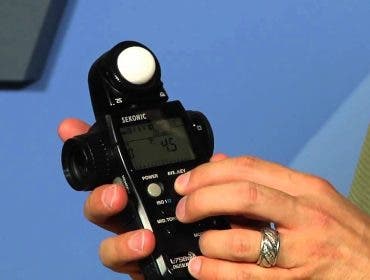
Hands-On Report:Leica S2Medium format digital quality in a pro 35-size package?By Jason Schneider, Reporting from PhotokinaSept. 24, Cologne, Germany: Sure, the 30x45mm size Kodak CCD sensor in the new Leica S2 is the hot news, but there’s nothing like hefting it to get the idea that there’s a new game in town. It is a big camera all right, but no bigger or heavier than a Nikon D3, canon EOS 1Ds Mark III. Its ergonomics are excellent as you can see in picture of Leica marketing guy Justin Stailey holding it in shooting positiuon. Indeeed, the Leica S2 may be a bit shorter in height than most 35mm-based pro DSLRs despite its massive 37-megapixel sensor. Also fascinating are the new lenses—the standard optic is a 70mm f/2.5 Summarit-S ASPH CS, and there’s a 100mm, a 120mm f/2.5 Apo-Summarit CS equivalent to roughly a 100mm (yes, you reduce number to calculate the 35mm focal-length equivalent with larger-sensor cameras) an Apo-Tele-Elmar 350mm f/3.5, a PC lens, and a 24mm f/2.8 Elmarit-S equivalent to an ultra-wide 19mm. How much will this all cost. Leica is keeping mum for now, but hopefully it will be less than top medium-format digital contenders like the Hasselblad S3.That’s one BIG sensor. The 30-45mm CCD in the Leica S2 (foreground, left) dwarfs a full-frame sensor placed next to it.Handy? You bet! Leica S2’s contours cradle nicely in shooting position and balanced is excellent.What’s Up at Olympus?Cool new concepts and mind-blowing mock-upsWhen it came to floating fascinating trail balloons, Olympus was the company to beat at Photokina 2008. They unleashed two concept cameras that had everybody gabbing about the future of both the standard and Micro Four Thirds format and what was really up the company’s sleeve. To get the full scoop we chatted with Sally Smith-Clemens, Olympus’ vivacious product manager. Here’s what she said on the record.“Neither camera has a name at the moment, but the first is pretty close to production, Basically it’s a model in between the professional Olympus E-3 and the compact E-520, but many of the features are E-3-ish, including 11-point AF, shadow adjustment technology, face detection, and a fully articulated LCD. We’re frankly targeting new DSLR enthusiasts who want to step up. That’s why the camera has a new set of creative controls that add new functionality not available on present models, I can’t be more specific at the moment, but think Cokin filters, and other elements that would appeal to a graphic artist who wanted to do things at the capture phase rather than in post-production. Actually it would have to be digital so your guess of software is not off the mark, In any event we expect to announce it during the first quarter of 2009.”How’s this for size: Olympus E-42O “most compact DSLR,” left, and new “rangefinder-esque” interchangeable lens digital compact concept camera in retro-style livery. Right: Sally Smith-Clemens holding the two very hand-holdable models.“The next camera is really an example of starting with a clean sheet of paper—it’s a camera that’s a lot smaller than the Olympus E-420 (which, by the way is about the same size as the new Panasonic Lumix G1) and it’s aimed at enthusiasts who want an interchangeable-lens camera that’s really pocketable—think retro rangefinder style, not DSLR. This is a camera that’s designed to lure more DSLR owners who may be attracted to a rangefinder-esque body, and to increase the percentage of sales among average shooters, only 7% of the camera market now consists of DSLRs. It will be in Micro Four Thirds format with lenses matched to the aforementioned form factor, and it may not even have a conventional eye-level viewfinder!” Enthusiast Olympus? New “E-3-ish” prototype will have feature set appealing to step-up enthusiasts and creative photographers.Interview: Yasunori TakasePanasonic Exec comments on the new Lumix G1 and moreAt the big Panasonic booth at Photokina we spoke with Yasunori Takase (above, holding a Panasonic Lumix G1), a top exec at the Pansonic Consumer Electronics Company of North America about the exciting new Lumix G1 (shown below from the back with flip-out LCD monitor), one of the stars of this year’s show. Here are some of his insightful remarks.“We do not see Micro Four Thirds in general or the Lumix G1 in particular as expanding a current DSLR sector but creating a new one in between the point-and-shoot and DSLR categories by causing more users top step up from a point and shoot. Many average users consider present DSLRs to be too big, heavy and complicated, and we want to create a demand for a new class of camera that meets their needs and wants. “We want to serve this expanding group of consumers by enhancing the potential of the camera itself. That’s why we are planning a long-range zoom lens and a flat, pancake-type high-speed lens of wide f/1.7 aperture for the Micro Four Thirds system, and it’s also why we’ve already announced a new companion version slated for this spring which will have HD movie capability. “We are also working on a special video lens that will have convenient controls and extra quiet zooming operation. Many have asked why make DSLRs with HD movie capability, but the real question is why not? People don’t want to have to carry a DSLR and a camcorder so why not expend the market by giving them what they want. We have specifically designed the G1 in colors and are offering it a the very attractive intro price of $799 MSRP in the US. Oh yes, to answer your technical question, the G1 has a vertical travel metal focal-plane shutter located in front of the image sensor.”BACK TO THE PHOTOKINA FLASH HOMEPAGE© 2008 Adorama |



